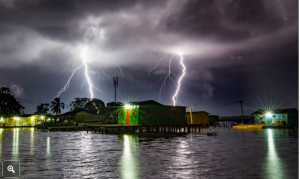 They call it “the Never-Ending Storm of Catatumbo,” or “Maracaibo’s Lighthouse.” Its lightning is so familiar, people in the state of Zulia in Venezuela even put it on their flag.
They call it “the Never-Ending Storm of Catatumbo,” or “Maracaibo’s Lighthouse.” Its lightning is so familiar, people in the state of Zulia in Venezuela even put it on their flag.
Less than half an hour after the first cloud forms, it starts to flash. It does this faster and faster — 200 flashes a minute is not uncommon. After that, the cloud becomes a giant bulb that lights up the night.
“You can read a newspaper in the middle of the night because it’s so bright,” said Jonas Pointek, a photographer who has documented the storms.
Locals in the area known as Lake Maracaibo, by the Catatumbo River in Venezuela, can expect a display of this sort during more than 80 percent of the year, mainly from April to November — an average of 297 days, to be exact, according to an analysis published in the Bulletin of the American Meteorological Society.
This was enough that NASA has declared the area the lightning capital of the world, dethroning Africa’s Congo Basin. The reason for the change: Sixteen years worth of data from the lightning sensors on a satellite allowed the team to analyze the numbers with unprecedented precision.
“Storm chasers have to drive down highways or up mountains,” said Alan Highton, of Catatumbo Camp, who has specialized in lightning tourism in the area for eight years. “But the unique thing about the Catatumbo is you can just sit there at our camp, drink a cold beer, and the storms will come to you.” He says the prettiest storms come in November, and according to the data, they peak in September. Read More
Read the entire article at The New York Times.
This was originally published on The New York Times written by Joanna Klein.






Leave a Reply